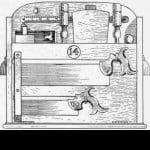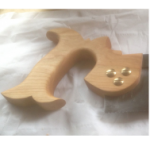Paul's Sharpening Method
Welcome! / Forums / General Woodworking Discussions / Tools and Tool Maintenance/Restoration / Paul's Sharpening Method
Tagged: free hand, freehand, sharpening
- This topic has 45 replies, 23 voices, and was last updated 10 years, 8 months ago by
 Franco.
Franco.
-
AuthorPosts
-

[quote quote=10772]If you are finding your narrow chisels are becoming skewed then I would suggest you lighten up on the pressure. I’ve honed my straight razors for years and frequently find people just learning to hone apply way too much pressure. I’m thinking the same thing applies to narrow chisels, there is not alot of metal and the less pressure should lead to more control of the chisel over the stone.[/quote]
I can attest to this, I had the problem with the skewed chisels when I started with Paul’s method. But with the help of many from the forum I lighten up the pressure while sharpening and have not had any problem after that.
[quote quote=10752]
Kelly Scroggins wrote:
I’ve only used the free hand method on blades from 2″ down to 1/4″. …Kelly- … On second thought, I do not even own a chisel narrower than 1/4″, so Kelly – send me your nicest 1/8″ chisel so I can do a test.
 [/quote]
[/quote]laffs!
[quote quote=10772]If you are finding your narrow chisels are becoming skewed then I would suggest you lighten up on the pressure. I’ve honed my straight razors for years and frequently find people just learning to hone apply way too much pressure. I’m thinking the same thing applies to narrow chisels, there is not alot of metal and the less pressure should lead to more control of the chisel over the stone.[/quote]
That sounds like a very reasonable approach. I’ll keep that in mind the next time I work on those narrow blades.
Thanks Dave.
5 June 2013 at 4:37 pm #13072I’ve practiced Paul’s sharpening method and am very pleased with the results, the only drawback is the shaving rash on my bald forearms!!!
It is quick and relatively easy and helps drag you away from mindset of a tool fetishist and gives you confidence that your tools are sharp enough to do what you need them to. I feel like it has given me the confidence to practice my woodworking rather than obsessing about whether my tools were set up properly.
It was a real revelation to see how much easier it is to work with a perfectly sharp tool and also to see how much neater the produced results are.
I am a real novice so, at first, I found it helpful to draw on the tip of the chisel with a sharpie so that I could see where I was taking off metal and secondly I drew a line at 30 degrees on a scrap of wood to give me a rough idea of an angle to work to. It doesn’t take long to develop the sensitivity to pressure, getting the angle and dipping at the end of the movement.
I can also recommend Paul’s video on sharpening saws using a progressive ripcut style. I am pleased with the results I am seeing despite never having attempted to sharpen a saw before.

[quote quote=13072]I’ve practiced Paul’s sharpening method and am very pleased with the results, the only drawback is the shaving rash on my bald forearms!!![/quote]
Nice Adam.
To conserve my manly arm hair, I just use look for any light reflection on the cutting edge so I know if there is any burr left on the chisel. Once I have worked off every bit of burr using the strop, I know I’m sharp.
28 August 2013 at 6:57 pm #17197I can testify, I too have recently tried Pauls method, and have been totally impressed. I have all the paraphernalia, tormek, various jap water stones etc. After seeing Pauls videos, I dug out an old unused norton combi stone (you would get laughed at on some forums for using one of THOSE…) Anyway I had a set of 5 stanley chisels, which had “average” edges, actually the bevels were to some extent rounded from careless haphazard attempts at honing on waterstones. I used plain white spirit as a lube, and in just a few minutes all 5 chisels came up paring slicing sharp (easing cleanly thru end grain pine) I watched the wire edges just curl off as I stropped them (on solvol autosol polish on leather) I realised all of a sudden that the beauty of this time honoured and traditional method is that it works WITH (not against) the natural motions of a tool relative to a sharpening stone-raised up a little towards the back of the pass across the stone and dropped down a little as it reaches the front. Instantly I was freed from the tiresome need to perfect a stance and motion that mimics a honing guage, to maintain a steady angle at all times…..Not only that, but I suddenly thought wow all I really need is one stone, I no longer need the tormek and a stack of fiddly, fragile and temperamental waterstones and the quasi religious routines required to use them..Anyway the set of 5 chisels are suddenly revitalised and useful (even if they dont stay sharp for long) but I was simply astonished at how fast and efficient this method is, so a quick retouch every now and again is just the thing! LOL the sharpening industry wont like it..!!
Cheers Jonathan 31 August 2013 at 2:54 pm #17290
31 August 2013 at 2:54 pm #17290I finally did it! I sharpened 4 plane irons last night, no jig, and all in less time than doing one with my old jig method including resharpening the two that didn’t come out “right” the first time.
Things I learned:
This is a learned skill. If I don't keep working at it I don't get better. WATCH how Paul positions his hands Stand up. I can't do it sitting down. I'm not going to do it as fast as Paul can any time soon. I don't need to do it as fast as Paul can. It's still pretty damn fast. If I don't like the result I can do it again. Still faster. I'm not shooting for perfection. The purpose is to put the tool into shape to work wood. The irons are still hair popping sharp which is pretty cool. The wood does not seem to know the difference between a 27 degree bevel and a 33 degree bevel when using a bevel down plane. Seriously. It's like it doesn't even care.Okay, on to sawing at a right angle in two dimensions. One dimension down (thank you knife wall) and one to go.
John
P.S. I managed to keep my sense of humility after this Herculean feat by reassembling two planes incorrectly and dropping my Paul Sellers tomato can oiler into the bucket of water I use to wash the diamond plates. Oh well, I wanted to make a Left Handed version any way.
10 October 2013 at 4:06 am #19803Just a quick question here concerning the DMT Diamond Stones.
Are they the 2×6 or the 3×8 stones? Or doesn’t it matter so long as they are course, fine, super fine?
 10 October 2013 at 4:12 am #19804
10 October 2013 at 4:12 am #19804William I like the 3X8 ones myself. I think Paul uses the 3X8 as well.
10 October 2013 at 6:48 am #19805You know John, I kind of thought that was the case, trying to judge the size of his plane irons and such against the stones. But before I go out and throw $210 on diamond stones I thought I better ask.

 10 October 2013 at 9:32 am #19808
10 October 2013 at 9:32 am #19808[quote quote=19803]Are they the 2×6 or the 3×8 stones? Or doesn’t it matter so long as they are course, fine, super fine?
[/quote]
@theolan Paul uses the 8×3″ ones at the school.I bought a couple of the 6×2″ stones a while back and they’re too small to sharpen tools comfortably, so replaced them with 8×3″. They’re not cheap but they’ll last a long, long time. Sharpening is something you do a lot of so it needs to be comfortable and quick!
George.
 10 October 2013 at 1:40 pm #19815
10 October 2013 at 1:40 pm #19815William,
You might also want to read this response Paul made on his blog:
http://paulsellers.com/2012/05/questions-answered-diamond-sharpening-plates/
Different makers refer to different grits with their labels so be sure you’re getting the grit size Paul is talking about. It’s the grit that does the work and not the label on the side. Lately I’ve seen new fly by night operators getting into the diamond stone manufacturing area. I’d stick to EZE-Lap (my preference) or DMT if I were you. I can’t afford to buy tools twice.
And George Birdman’s response is right on the money twice. These stones aren’t cheap up front but they’re pretty much a one time investment and their speed and convenience turn sharpening from a “when it really needs it” chore into a normal part of your daily work putting away tools. Which means everything is razor sharp and ready to go when you start work the next day. Or at least that’s how it’s working out for me.
Do look around for pricing. I like to shop local when I can find what I’m looking for within my means but when I can’t get what I want that way I go with Amazon as Scott pointed out above.
John
 10 October 2013 at 2:40 pm #19817
10 October 2013 at 2:40 pm #19817Trend do a range of plates as well they are quite expensive they are good for flatness main problem most of them double sided.
http://www.trend-uk.com/en/UK/productlist/3/280/diamond_bench_stones.html
I have 2 trend plates 1 x extra course 8″ x 3″ 180 g and double sided 7″ x 2 1/2″ 300 g course and 1000 g fine.
I also have 1200 g EZE lap.
I want to add the other EZE laps and make sharpening board as I am turning to the plates more now than any other media.
I do have a Tormek and its nice to bring primary bevel back to order.
I’m not a total convert to Paul’s method as I have sharpened tools free hand and use of a guide for years. Must admit still like my oil stone.
I just thought I would give another option on Diamond plates DMT, EZE lap, and Trend. -
AuthorPosts
- You must be logged in to reply to this topic.
